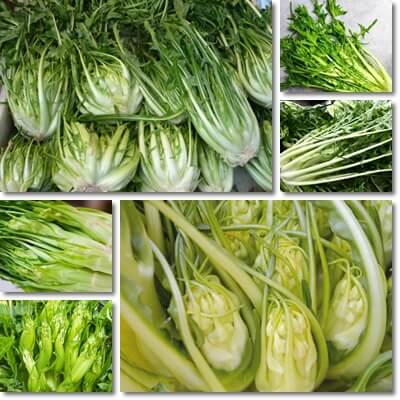Asparagus chicory is a type of endive, essentially a salad green in the chicory family. The Italians call it puntarelle, but in the West it’s better known as asparagus chicory, Italian dandelion chicory or Catalonian chicory. The salad green is a staple in Italian cuisine, along with other chicories such as radicchio and endive, and a source of good nutrition and important benefits for health.
What is asparagus chicory?
Asparagus chicory is known under the scientific name Cichorium intybus var. foliosum, and it’s a variety of common chicory. It’s closely related to Belgian endives and radicchio, also varieties of common chicory. In Italy, preferred names for asparagus chicory include cicoria asparago (translated as ‘asparagus chicory’), puntarelle, or cicoria di Catalogna (translated as ‘Catalonian chicory’).
In English speaking countries, the salad green is also referred to as Italian dandelion endive, to mark the fact that is a type of endive, and related to dandelions. Some people call it puntarelle chicory, puntarelle salad or puntarelle greens to indicate its uses.

What does asparagus chicory look like?
If you ask someone who hasn’t seen or eaten asparagus chicory to tell you what it looks like, they wouldn’t be able to. Asparagus chicory has quite the unusual appearance: the green vegetable has sprawling white to pale green or yellowish-green stems with upright dark green, serrated, dandelion-like leaves. The stems are tightly packed at the base, almost bulbous in appearance in some plants, and either long and slim or short and thick.
What does asparagus chicory taste like?
The taste of asparagus chicory depends on the age of the vegetable at harvest time. Young asparagus chicories taste the best: only mildly bitter, with crisp, juicy, tender stems and leaves.
Older chicories tend to have a more pregnant bitter taste, especially in the leaves. Depending on the vegetable, only the leaves, called greens, may be eaten, or the leaves and stems. You can eat asparagus chicory raw and cooked.
Asparagus chicory nutritional information
Asparagus chicory nutrition facts
- High vitamin K content – around 200% of the daily recommended intake for the average adult per 100 g of greens.
- Good content of vitamins B5, B9, pro-vitamin A, manganese.
- Good content of potassium, zinc and vitamins B1, B2 and C.
- Contains small amounts of vitamin B3, calcium, iron and phosphorus.
- Very low in calories – only 20 kcal per 100 g.
- Dietary fiber content: 3 g of dietary fiber per 100 g.

Asparagus chicory benefits
Digestion aid
Asparagus chicory acts as a digestive – it helps stimulate the production of digestive juices and aids digestion along. Eating the pleasantly bitter greens raw or cooked helps move digestion along.
Anti-inflammatory food
Asparagus chicory greens have a high content of vitamin K – approximately 2 times the recommended intake of the vitamin per 100 g of greens. Vitamin K has scientifically proven anti-inflammatory effects, helping lower levels of inflammatory biomarkers such as interleukin 6. Asparagus chicory also contains small amounts of vitamin C with additional anti-inflammatory benefits.
Anti-bleeding effects
Asparagus chicory greens are high in vitamin K which is known to have anti-bleeding effects. Vitamin K naturally stops bleeding by activating blood coagulation-associated processes via a blood coagulation factor called prothrombin. A sufficient intake of vitamin K from food, as well as vitamin C to strengthen capillary walls, helps combat nosebleeds and easy bruising.
Good food for losing weight
With only around 20 kilocalories per 100 g, asparagus chicory is classified as a very low-calorie food which can successfully be included in a weight loss diet to help you lose weight in a healthy way, whilst also providing good nutrition.
Good for high cholesterol
Asparagus chicory provides phytosterols, cholesterol-like plant compounds that outcompete cholesterol for absorption. The winter vegetable is also high in dietary fiber, with 3 g of fiber per 100 g, which further helps reduce cholesterol absorption from food. Asparagus chicory is very low fat and low-calorie, helping with weight loss and weight management, two key aspects of high cholesterol management.
Benefits for osteoporosis
Leafy green vegetables such as asparagus chicory are some of the best foods to eat to reduce risks of osteoporosis and associated bone fractures. Vitamin K in asparagus chicory regulates calcium metabolism, sending calcium from the foods you eat into bones and teeth for better bone integrity. Asparagus chicory also provides smaller amounts of dietary phosphorus and calcium for bones and teeth mineralization.
Cardiovascular benefits
Calcification is a process that causes calcium from the diet to accumulate in abnormal parts of the body, such as cartilage, joints and ligaments, heart valves and blood vessels. Calcification is favored by a high calcium-low vitamin K content, inflammation and other factors. Foods high in vitamin K, such as asparagus chicory, exert anti-inflammatory effects and regulate calcium metabolism, reducing risks of calcification in the arteries and heart valves.
Good food to eat during pregnancy
Asparagus chicory greens make a good food to eat during pregnancy, in moderate amounts. The greens have a good content of vitamin B9 which is needed for the proper development of the baby in pregnancy – vitamin B9 helps prevent defects of the brain, spine and spinal cord. Asparagus chicory is also a good source of vitamins B1, B2 and contains small amounts of iron and vitamin B3 which further help combat tiredness and fatigue, and have an energizing effect.
Good food to eat for diabetics
Diabetics can eat asparagus chicory, and enjoy benefits for their condition from doing so. For one, the vegetable is low-calorie and very low-fat, and helps with weight loss and weight managements, key aspects of diabetic health.
Asparagus chicory is also a low glycemic food, with both low glycemic index and low glycemic load values. Because it’s low glycemic, it has very limited effects on blood sugar and can help reduce insulin resistance. Asparagus chicory is also a source of potassium, vitamin K, calcium and phosphorus which hold benefits for cardiovascular health.
Benefits for vision
Asparagus chicory greens are high in pro-vitamin A carotenes such as beta-carotene. Regular consumption of the greens supports good visual acuity, and eye health, with benefits for color vision and vision in low light, dubbed night vision.
Asparagus chicory side effects
- Allergic reactions. Asparagus chicory belongs to the Asteraceae family and can cause allergic reactions with the potential for anaphylactic shock. Avoid the vegetable if you are also allergic to dandelion, chamomile, daisies, Echinacea (coneflowers) or sunflower, radicchio or endives.
- Higher risk of blood clots. If you have a predisposition for blood clots, and are receiving anticoagulant medication for your condition, avoid dark leafy greens high in vitamin K, including asparagus chicory, kale, chard etc.
Asparagus chicory recipe ideas
Mediterranean-style salads
Asparagus chicory greens, or greens and stems, with blanched endive leaves, extravirgin olive oil, salt, pepper, and other ingredients of your choice (tomatoes, garlic, olives, sheep milk’s cheese such as Italian pecorino, parmesan shavings, croutons or bruschetta).
Puntarelle alla romana
This classic Italian recipe is basically asparagus chicory stems cut in very thin strips with a dressing made from a couple of crushed garlic cloves and crushed anchovies with salt, pepper, extravirgin olive oil and vinegar.
Risotto and pasta
Two of the best recipe ideas for asparagus chicory greens. Clean and lightly cook the leaves in a pan (15-20 minutes), season with salt, pepper, extravirgin olive oil and garlic, then add to risotto or pasta like spaghetti or penne. Pair with mushrooms for the risotto, or gorgonzola, artichoke and caramelized onions for the pasta. You can even use it as a pizza topping, with pancetta, bresaola or prosciutto crudo.
Cooked asparagus chicory greens
In Italian cuisine, asparagus chicory greens and stems are often eaten separately. You can eat the leaves or greens raw, in salads, or cook them. Cooked asparagus chicory greens are called ‘puntarelle cotte’ in Italian, and they are cooked in the pan ‘in padella’ until soft, and seasoned simply with salt and extravirgin olive oil, even garlic.
